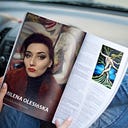Peter Voulkos — abstract expressionist ceramic sculptures
“Peter Voulkos began working in ceramics during his senior year at Montana State College in 1949. In 1952, he completed his MFA at the California College of Arts and Crafts and went on to teach at the Otis Art Institute for five years. Afterwards, Voulkos transferred to the University of California, Berkley to establish the Ceramics Department where he worked until his retirement in 1985. Peter Voulkos has often been dubbed the father of the American Clay Revolution, otherwise known as the Craft-to-Art movement. In 1954, Voulkos’s hefty clay sculptures smashed the boundaries and constraints of utilitarian ceramics with three categories of work: “ice buckets,” “plates,” and “stacks.” While teaching at the Otis Art Institute (then the Los Angeles County Art Institute), Voulkos’s clay constructions began to embody the gestural spontaneity and visual momentum of Abstract Expressionism along with the Zen-like acceptance of imperfections that characterizes the Japanese tradition of pottery. Working with a personal structural vocabulary limited to thrown shapes including cylinders, bowls, spheres, plates, clay slabs, and whatever forms his hand or mallet could tear, press, or paddle, he fabricated a unique visceral and sculptural syntax with infinite compositional variations. To quote the artist, “I get down to the very basic forms that I really love, but they are still giving me information.” Voulkos’s one-person shows include those at the Los Angeles County Museum of Art, CA; the Museum of Modern Art, NY; the Pasadena Museum of Modern Art, CA; and the Art Institute of Chicago, IL. His work is represented in collections throughout the United States, Europe, and Japan. He died on February 16, 2002.”
